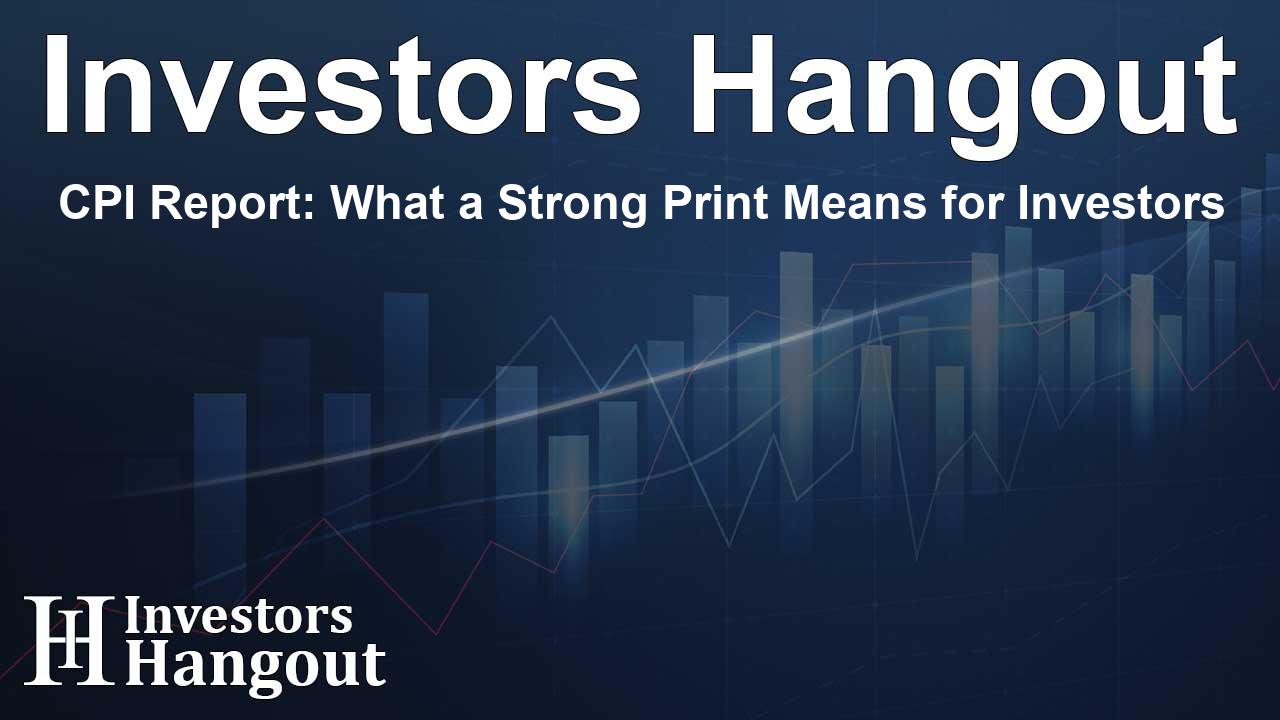CPI Report: What a Strong Print Means for Investors

Understanding the Upcoming CPI Report
The much-anticipated U.S. Consumer Price Index (CPI) report for December is set to be released soon, and it promises to provide insights into inflation trends that can shift the tides of market sentiment. Investors are preparing for what could be a critical disclosure, with expectations suggesting a notable rise in both headline and core inflation metrics.
Economic analysts predict a 2.9% increase in headline annual inflation, coupled with a core CPI rise of 3.3%. These figures matter significantly, especially in a landscape laden with uncertainty regarding the Federal Reserve’s monetary policy. A CPI reading that exceeds expectations could accelerate shifts in investor outlook, effectively adjusting the anticipated timeline for rate cuts.
Market Sentiments and Possible Reactions
The CPI report serves as a bellwether for market participants, often leading to substantial volatility in asset prices across equities and bonds. Should the inflation metrics surprise to the upside, it could spark concerns regarding consumer price stability, prompting traders to reconsider their portfolios.
As Wall Street actively gauges the Federal Reserve's response to inflation data, a hotter-than-expected CPI print could push upwards of interest rates, causing ripples throughout the financial markets. A softer inflation report, on the flip side, might reignite hopes for Fed rate cuts in the near future—ideal for sectors sensitive to interest rate movements, such as technology and discretionary consumer stocks.
Impact of Inflation on Financial Assets
When inflation rises, confidence in various asset classes fluctuates accordingly. For example, in the face of increased CPI readings, treasury yields could rise sharply, negatively affecting equities, especially those that rely on cheaper borrowing costs for growth. Notably, tech stocks may feel the brunt of such adjustments.
Recent trends have shown that higher treasury yields correlate with diminished investor appetite for risky equities as the cost of capital escalates. Thus, targets for the S&P 500 and similar indices may come under scrutiny, reflecting a cautious approach among investors.
Strategies for Navigating Inflation Data
As we gear up for the CPI report, formulating a resilient investment strategy becomes essential. Investors should consider tailoring their portfolios to respond effectively to the possible outcomes of the report. A prudent move might include minimizing exposure to risky assets immediately preceding the report's unveiling while keeping an eye out for buying opportunities post-release.
Adjusting to Market Signals
In a rapidly changing market landscape, flexibility could be advantageous. If the CPI reports higher inflation, diversifying into inflation-protected assets, such as Treasury Inflation-Protected Securities (TIPS), may prove beneficial while mitigating exposure to growth stocks vulnerable to higher yields.
On the other hand, if the report reveals weaker-than-expected inflation numbers, sectors poised for accelerated growth, such as technology and consumer discretion, may become favorable. Investors may even consider exchange-traded funds (ETFs) that focus on high-growth areas to capture potential upside in bullish markets.
Conclusion: Preparing for Market Volatility
The December CPI report stands as a pivotal moment for market dynamics, setting the stage for how investors should navigate the economic landscape going into the next year. Understanding the implications of inflation data and remaining adaptable will be crucial for steering through potential market volatility.
Whether inflation trends strengthen or moderate, maintaining a diversified portfolio filled with quality assets is vital. Monitoring economic indicators constantly can provide a nuanced approach to investing, enabling individuals to seize tactical opportunities as they arise.
Frequently Asked Questions
What is the CPI report?
The CPI report measures the average change over time in the prices paid by consumers for goods and services, serving as a key indicator of inflation.
Why is the CPI important for investors?
The CPI provides insights into inflation trends, helping investors gauge future interest rate changes and adjust their investment strategies accordingly.
What happens if the CPI exceeds expectations?
An unexpectedly high CPI may lead to fears of persistent inflation, which could deter rate cuts, impacting equity and bond markets negatively.
How should investors react to differing CPI outcomes?
Investors should consider reallocating their assets based on CPI results, favoring inflation-protected instruments in case of rising inflation and growth stocks in case of lower inflation.
What are TIPS?
Treasury Inflation-Protected Securities (TIPS) are U.S. government bonds specifically designed to protect investors from inflation, as their principal increases with inflation.
About The Author
Contact Hannah Lewis privately here. Or send an email with ATTN: Hannah Lewis as the subject to contact@investorshangout.com.
About Investors Hangout
Investors Hangout is a leading online stock forum for financial discussion and learning, offering a wide range of free tools and resources. It draws in traders of all levels, who exchange market knowledge, investigate trading tactics, and keep an eye on industry developments in real time. Featuring financial articles, stock message boards, quotes, charts, company profiles, and live news updates. Through cooperative learning and a wealth of informational resources, it helps users from novices creating their first portfolios to experts honing their techniques. Join Investors Hangout today: https://investorshangout.com/
The content of this article is based on factual, publicly available information and does not represent legal, financial, or investment advice. Investors Hangout does not offer financial advice, and the author is not a licensed financial advisor. Consult a qualified advisor before making any financial or investment decisions based on this article. This article should not be considered advice to purchase, sell, or hold any securities or other investments. If any of the material provided here is inaccurate, please contact us for corrections.
